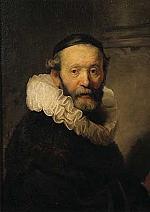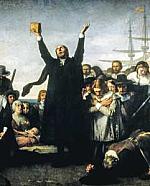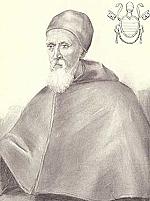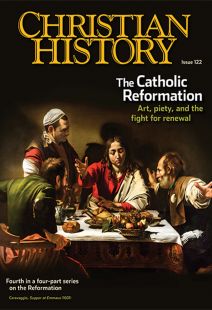Reasons of state
 “EVERYWHERE THERE IS ENVY, hatred and greed: that’s what the war has taught us. … We live like animals, eating bark and grass. … Many people say that there is no God. …” These lines, inscribed in a family Bible in a small south German town in 1647, bear witness to the profound trauma inflicted by the waves of warfare that swept central Europe between 1618 and 1648.
“EVERYWHERE THERE IS ENVY, hatred and greed: that’s what the war has taught us. … We live like animals, eating bark and grass. … Many people say that there is no God. …” These lines, inscribed in a family Bible in a small south German town in 1647, bear witness to the profound trauma inflicted by the waves of warfare that swept central Europe between 1618 and 1648.
Known collectively as the Thirty Years’ War, these conflicts began as a civil disturbance within a single dominion of the Holy Roman Empire. But they evolved into an existential struggle over the constitution of the empire and the balance of power in seventeenth-century Europe. They ended as the most destructive war the continent had yet known and the first to ensnare, directly or indirectly, virtually every European power of note. The terms of its conclusion would transform the social, religious, and political landscape of Europe—and, some would say, of the world.
[The second defenestration of Prague; Wikimedia]
this is getting complicated
Tensions had long been gathering within the federation of semi-autonomous principalities known as the Holy Roman Empire. By law the empire was an elective monarchy, but Europe’s most powerful family, the Habsburgs, ruled it as if by hereditary right. Just below the emperor in the hierarchy were seven prince-electors, who ranked above a host of other princely states and several free cities. An imperial diet gave representation to all of these parties. The states were further organized into circles, each with its own diet, and each state or free city also had internal hierarchies.
To compound the complexity, centuries of alliances and transactions had produced a host of overlapping jurisdictions and interlocking chains of allegiance. And that was all before the Protestant Reformation.
After 1517 religious strife and competition for power and property splintered this intricate organism into rival networks, largely along confessional lines. But the Peace of Augsburg (1555) brought a durable if uneasy coexistence—Lutheranism was legally recognized; princes determined the religion of their own states; Protestants could retain church lands they had taken before 1552, but not after; and Protestantism was permitted in certain Catholic cities where it had been long established.
For 63 years those terms largely held. But as the seventeenth century dawned, the empire found itself increasingly vexed by discontent. Catholics resented Protestants continuing to appropriate ecclesiastical holdings, contrary to Augsburg’s terms. Meanwhile Protestants objected to Catholic efforts to curtail Protestant privileges and re-Catholicize Protestant princes and their subjects. The spread of Calvinism—not recognized at Augsburg—caused additional strains.
By 1609 two opposing defensive alliances, the Protestant Union and the Catholic League, had mobilized. As tensions rose the mechanisms for resolving them diminished. Protestant-Catholic distrust paralyzed the court system, and after 1613 the imperial diet ceased to convene. Increasingly the Peace of Augsburg seemed less a peace and more a long deferment of war.
out the window with you
Issues came to a head in 1618 in Bohemia, where a Catholic king ruled a largely Protestant people whose nonconformity traced back to the Hussite movement of the early 1400s. To complicate matters Bohemia was one of the empire’s seven electorates and had, since the early 1500s, been governed by the Habsburgs, giving them a decisive edge in the imperial electoral process. The Catholic Austrian Habsburgs had indulged their Protestant Bohemian subjects as long as the peace of the realm went undisturbed. In fact, in 1609, Emperor Rudolf II issued a “Letter of Majesty” that guaranteed religious freedom in Bohemia, permitted new Protestant chapels on royal lands, and commissioned an assembly of “Defenders” to protect these liberties.
In 1612 Rudolf’s brother Matthias ascended to the Bohemian throne, aged and childless. More zealous members of his family, with Spanish Habsburg support, promoted as his successor Jesuit-trained Archduke Ferdinand of Inner Austria (1578–1637)— who dreamed of uniting the Holy Roman Empire under a single ruler and a single church. Ferdinand was appointed crown prince of Bohemia and heir apparent to Matthias in 1617. Working through regents he quickly cracked down on Protestant liberties he deemed excessive.
On May 23, 1618, having in hand a threatening letter under Matthias’s name that the Defenders felt sure had been penned by Ferdinand’s regents instead, the furious lords stormed the royal palace in Prague and burst into the council chamber. There, in conscious imitation of fabled Hussite revolutionaries almost exactly two centuries before, they seized three of their tormentors and tossed them out the window. Known as the Second Defenestration of Prague, the event by general agreement marks the beginning of the Thirty Years’ War.
These defenestratees survived the fall and escaped. Yet the Bohemian nobility and their allies, chiefly Frederick V of the Palatinate (1596–1632), now hoped to inspire an international Protestant alliance against the Habsburgs. Early returns were favorable: aid arrived from the Palatinate, Selisia, and Savoy, and, after the Protestants took control of Bohemia and pressed into Austria, still others joined the alliance.
The political calculus shifted, however, when Matthias died early the next year. Ferdinand was officially installed as king of Bohemia, and all signs pointed to his election as Holy Roman emperor. Shortly before that election, the Bohemian nobles, claiming a constitutional right to elect their own king, deposed Ferdinand and elevated the Protestant Frederick V. This was a provocative move which transferred Bohemia to a Palatine Calvinist and made Frederick a “double elector,” eligible to cast two votes in imperial elections. Already three of the seven electors, including Frederick V himself, were Protestant. A Protestant might soon reign over the Holy Roman Empire.
The ploy backfired. Armies from Spain and Bavaria raced to defend Ferdinand, duly crowned emperor as Ferdinand II. The Protestant Union chose neutrality, and some Protestants even sided with the emperor. The imperial coalition eventually routed the Bohemian army just west of Prague. Frederick fled into exile, and, by the end of 1622, Austria, Moravia, and Bohemia had been reconquered. Protestant nobles were exiled, their property seized, and Catholicism uniformly stamped on the realms. By 1624 the Palatinate lay firmly in imperial hands. The revolt had been utterly crushed.
The emperor’s very success now worked against him. He rewarded his most powerful supporter, Maximilian of Bavaria, with the lands and electoral dignity of Frederick V. This antagonized other German princes who were afraid of an emperor who could remove or install an elector at his pleasure. Protestants felt betrayed at the Palatinate being given to a Catholic prince. And the near total triumph of the Habsburgs raised alarm among their rivals, especially France. Their only hope: a new Protestant champion.
snatching defeat from victory
Christian IV of Denmark (1577–1648) answered the call. As duke of Holstein, he was also a prince of the empire, and in 1625 he raised an army to redeem Protestant losses and restore the injured rights of German princes. Christian internationalized the war, winning troop commitments and subsidies from England, Scotland, the Netherlands, and France.
Despite these advantages the Protestant cause promptly unraveled. The timing was inauspicious. Alongside Maximilian’s army Ferdinand II had also commissioned an imperial force under the brilliant, controversial Albrecht von Wallenstein, a minor Bohemian nobleman. Christian, expecting to face one army, found himself facing two. Then crises beset his international allies and delayed or reduced their promised contributions. After three costly years of battle, both sides took to the negotiating table where, in the Treaty of Lübeck (1629), Christian renounced future intervention in the empire.
Once again Ferdinand II stood at the brink of consolidating central Europe into a united Catholic empire. But once again he overplayed his hand.
First in 1628 he provoked the German princes by banishing the dukes of Mecklenburg, who had supported Christian, and giving their duchies to the deeply disliked Wallenstein—constitutionally irregular and politically unwise. A year later he issued the Edict of Restitution, demanding that Protestants return all lands taken from the Catholic Church since 1552 and targeting Calvinism for repression. The edict sent shock waves through the Protestant world, and even some Catholics saw it as a destabilizing attempt to undo 70 years of history.
Now King Gustavus Adolphus II (1594–1632) of Sweden arose to defend the Protestant cause. At his back was major financial sponsor France, fearful of Habsburg power. Furthermore the Edict of Restitution had outraged German Protestants; the combined effect of Catholic atrocities (most famously the brutal sacking of Magdeburg) and Swedish persuasion soon brought most to Gustavus’s side.
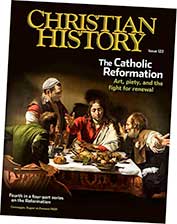 Order Christian History #122: The Catholic Reformation in print.
Order Christian History #122: The Catholic Reformation in print.
Subscribe now to get future print issues in your mailbox (donation requested but not required).
Gustavus’s expertise in the art of war proved advantageous, and, in contrast to Christian, he benefited from good timing. In 1630 the imperial electors at last persuaded Ferdinand II to remove the hated Wallenstein. Christian had invaded just as Wallenstein’s fearsome army was being deployed. Gustavus invaded just as it was being decommissioned.
Within two years Gustavus routed the imperial forces. Protestant armies occupied Bavaria and Bohemia, and Maximilian fled into exile. Facing defeat Ferdinand II turned again to Wallenstein. With the maligned general back in the field, the tide shifted once more. Imperial forces reclaimed lost ground, then pressed into Saxony. When the two great armies converged at Lützen in 1632, the Protestant army managed to prevail, but at an intolerable cost: alongside thousands of his troops, Gustavus Adolphus fell in battle.
a peace that was no peace
With costs mounting and neither side able to secure victory, secret negotiations began even as the battles raged. Internal divisions surfaced among Protestant princes. On the imperial side, Wallenstein’s enemies at court and his own erratic behavior poisoned his relationship with the emperor. In early 1634 Ferdinand II deposed Wallenstein and declared him guilty of treason. He was assassinated while attempting to escape.
In May of 1635, John George of Saxony, acting on behalf of the majority of the Protestant princes of Germany, agreed to the Peace of Prague. It suspended the Edict of Restitution for 40 years, enlisted all in a united imperial army, and forbade states to form alliances among themselves or with foreign powers. The German civil war seemed over, on terms favorable to Ferdinand II. Yet a Swedish army still encamped on the Baltic coast. And a great superpower, France, lay brooding. The longest and deadliest phase of the war was about to begin.
Catholic France’s stated aim was to defend German Protestant liberties, but it had few German allies and much interest in opposing the Habsburgs. The battle plan called for Sweden, aided by princes excluded from or disadvantaged by the Peace of Prague, to campaign in the east while France invaded the Spanish Netherlands and fought Habsburg armies along the Rhine.
At first this French-led alliance made only fitful advances. Before long however the complexion of the war turned. In 1637 Ferdinand II died and was succeeded by his eldest son, Ferdinand III (1608–1657). Calvinist countess Amalia Elisabeth, regent for her recently deceased husband, sought terms from Ferdinand III that would have removed her powerful Hessian army from the field. But he refused to grant legal recognition to Calvinists, so Amalia recommitted to the French alliance.
Now the alliance made great gains, and setbacks in the Netherlands and the New World and rebellions in Catalonia and Portugal forced Spain to withdraw. With all sides weary of war, treaty negotiations began in 1643, first at Frankfort, then at Osnabrück and Münster, in Westphalia. The talks stretched on, shaped and reshaped by the battlefield. “In the winter we negotiate,” remarked one participant. “In summer we fight.” On October 23, 1648, after five years of negotiation among almost 200 states and principalities, final terms were signed as the Peace of Westphalia.
Westphalia remade the status quo of central Europe. The long dispute over church property was resolved (Protestants retained lands confiscated prior to 1624). Historic religious concessions included legal recognition for Calvinism and toleration of private worship. Political adjustments were sweeping: formal independence for the Dutch Republic and Switzerland; limited autonomy for German states. And constitutional reforms required the emperor to win consent from the diet for major political decisions and subjected confessional disputes to resolution by “amicable” consensus, not majority vote. An eighth electoral vote re-enfranchised the Protestant elector Palatine.
As a whole these terms shifted power from the emperor to the German states, and from the Habsburgs to France and its allies. Implementation dragged on for years, and France and Spain would fight for another decade, but the Thirty Years’ War was over.
“sorely whipped”
Three decades of slaughter, forced flight, and destruction took a horrific toll. “Some nations are chastised with the sword, others with famine, others with the man-destroying plague,” wrote English minister Edmund Calamy. “But poor Germany hath been sorely whipped with all these three.” Disease, famine, and war-related violence on the battlefields and in countless skirmishes, riots, and uprisings cost the empire millions of lives, perhaps a quarter of its population.
But history has remembered the Thirty Years’ War mostly for its peace treaty. Westphalia encouraged allegiance to territorially defined states above all else—perhaps the decisive moment in the transition from medieval political structures to modern nation-states. It also marked a pivotal step toward norms of modern diplomacy: equality among sovereign states, reliance on international conferences, and balance-of-power politics. And it signaled the triumph of political pragmatism over religious authority. “Reason of state is a wonderful beast,” quipped one contemporary observer, “for it chases away all other reasons.” A powerful trend of political secularization had begun, continuing virtually unabated until the late twentieth century. By then it had come to be seen, mistakenly, as inevitable. CH
This article is from Christian History magazine #122 The Catholic Reformation. Read it in context here!
 Christian History’s 2015–2017 four-part Reformation series is available as a four-pack. This set includes issue #115 Luther Leads the Way; issue #118 The People’s Reformation; issue #120 Calvin, Councils, and Confessions; and issue#122 The Catholic Reformation. Get your set today. These also make good gifts.
Christian History’s 2015–2017 four-part Reformation series is available as a four-pack. This set includes issue #115 Luther Leads the Way; issue #118 The People’s Reformation; issue #120 Calvin, Councils, and Confessions; and issue#122 The Catholic Reformation. Get your set today. These also make good gifts.
By Roger G. Robins
[Christian History originally published this article in Christian History Issue #122 in 2017]
Roger G. Robins is an associate professor in the Center for Global Communication Strategies at the University of Tokyo.Next articles
Defender of God’s justice
Arminius questioned some aspects of Reformed faith, but he never meant to launch a movement
William den BoerRemaking the world
Five men with very different ideas on the reform of Sixteenth-century Catholicism
Edwin and Jennifer Woodruff TaitThe Catholic Reformation: Recommended Resources
Here are some recommendations from CH editorial staff and this issue’s authors to help you navigate the landscape of the Catholic Reformation and the effects of reform on into the seventeenth century.
the editorsSupport us
Christian History Institute (CHI) is a non-profit Pennsylvania corporation founded in 1982. Your donations support the continuation of this ministry
Donate



